PONTIAC GTO 2005 Owners Manual
Manufacturer: PONTIAC, Model Year: 2005, Model line: GTO, Model: PONTIAC GTO 2005Pages: 318, PDF Size: 2.06 MB
Page 1 of 318
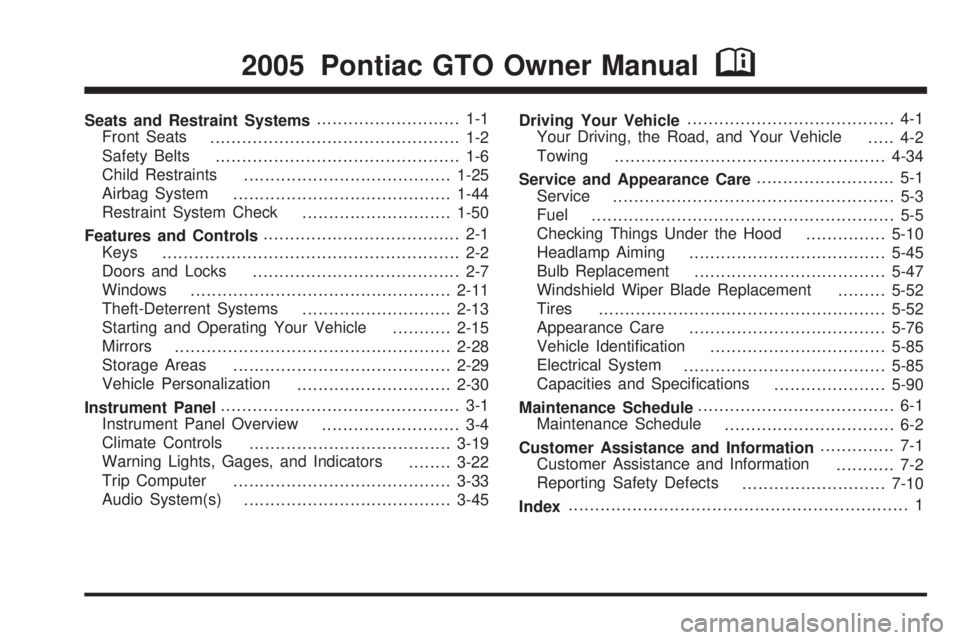
Seats and Restraint Systems........................... 1-1
Front Seats
............................................... 1-2
Safety Belts
.............................................. 1-6
Child Restraints
.......................................1-25
Airbag System
.........................................1-44
Restraint System Check
............................1-50
Features and Controls..................................... 2-1
Keys
........................................................ 2-2
Doors and Locks
....................................... 2-7
Windows
.................................................2-11
Theft-Deterrent Systems
............................2-13
Starting and Operating Your Vehicle
...........2-15
Mirrors
....................................................2-28
Storage Areas
.........................................2-29
Vehicle Personalization
.............................2-30
Instrument Panel............................................. 3-1
Instrument Panel Overview
.......................... 3-4
Climate Controls
......................................3-19
Warning Lights, Gages, and Indicators
........3-22
Trip Computer
.........................................3-33
Audio System(s)
.......................................3-45Driving Your Vehicle....................................... 4-1
Your Driving, the Road, and Your Vehicle
..... 4-2
Towing
...................................................4-34
Service and Appearance Care.......................... 5-1
Service
..................................................... 5-3
Fuel
......................................................... 5-5
Checking Things Under the Hood
...............5-10
Headlamp Aiming
.....................................5-45
Bulb Replacement
....................................5-47
Windshield Wiper Blade Replacement
.........5-52
Tires
......................................................5-52
Appearance Care
.....................................5-76
Vehicle Identification
.................................5-85
Electrical System
......................................5-85
Capacities and Specifications
.....................5-90
Maintenance Schedule..................................... 6-1
Maintenance Schedule
................................ 6-2
Customer Assistance and Information.............. 7-1
Customer Assistance and Information
........... 7-2
Reporting Safety Defects
...........................7-10
Index................................................................ 1
2005 Pontiac GTO Owner ManualM
Page 2 of 318
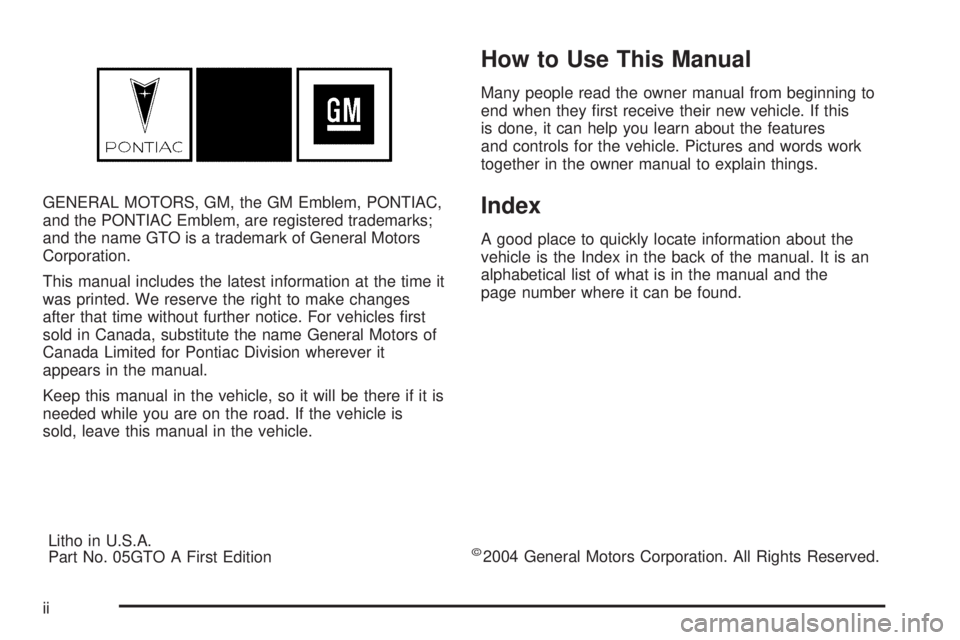
GENERAL MOTORS, GM, the GM Emblem, PONTIAC,
and the PONTIAC Emblem, are registered trademarks;
and the name GTO is a trademark of General Motors
Corporation.
This manual includes the latest information at the time it
was printed. We reserve the right to make changes
after that time without further notice. For vehicles first
sold in Canada, substitute the name General Motors of
Canada Limited for Pontiac Division wherever it
appears in the manual.
Keep this manual in the vehicle, so it will be there if it is
needed while you are on the road. If the vehicle is
sold, leave this manual in the vehicle.
How to Use This Manual
Many people read the owner manual from beginning to
end when they first receive their new vehicle. If this
is done, it can help you learn about the features
and controls for the vehicle. Pictures and words work
together in the owner manual to explain things.
Index
A good place to quickly locate information about the
vehicle is the Index in the back of the manual. It is an
alphabetical list of what is in the manual and the
page number where it can be found.
Litho in U.S.A.
Part No. 05GTO A First Edition
©2004 General Motors Corporation. All Rights Reserved.
ii
Page 3 of 318
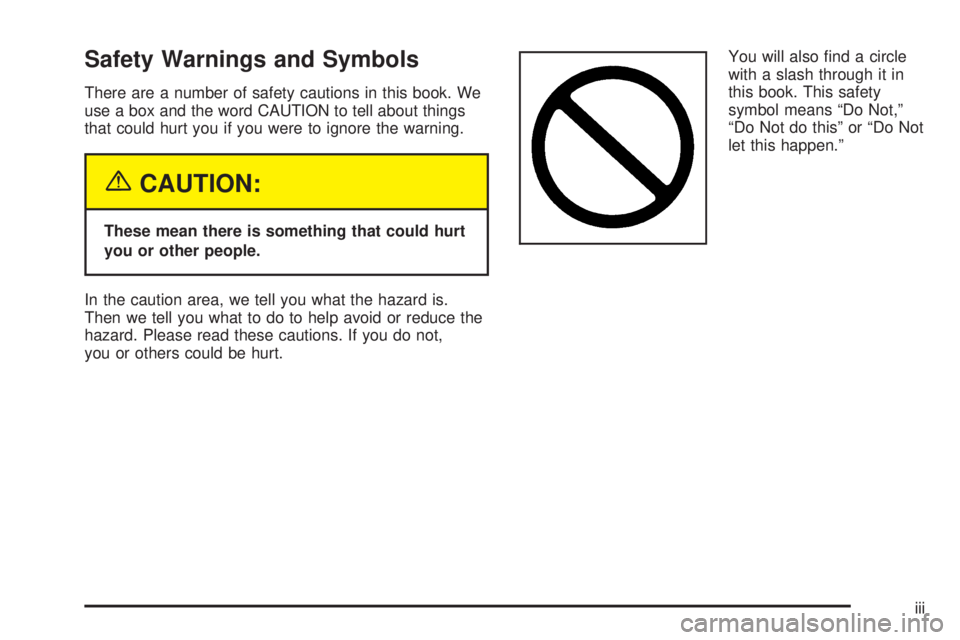
Safety Warnings and Symbols
There are a number of safety cautions in this book. We
use a box and the word CAUTION to tell about things
that could hurt you if you were to ignore the warning.
{CAUTION:
These mean there is something that could hurt
you or other people.
In the caution area, we tell you what the hazard is.
Then we tell you what to do to help avoid or reduce the
hazard. Please read these cautions. If you do not,
you or others could be hurt.You will also find a circle
with a slash through it in
this book. This safety
symbol means “Do Not,”
“Do Not do this” or “Do Not
let this happen.”
iii
Page 4 of 318
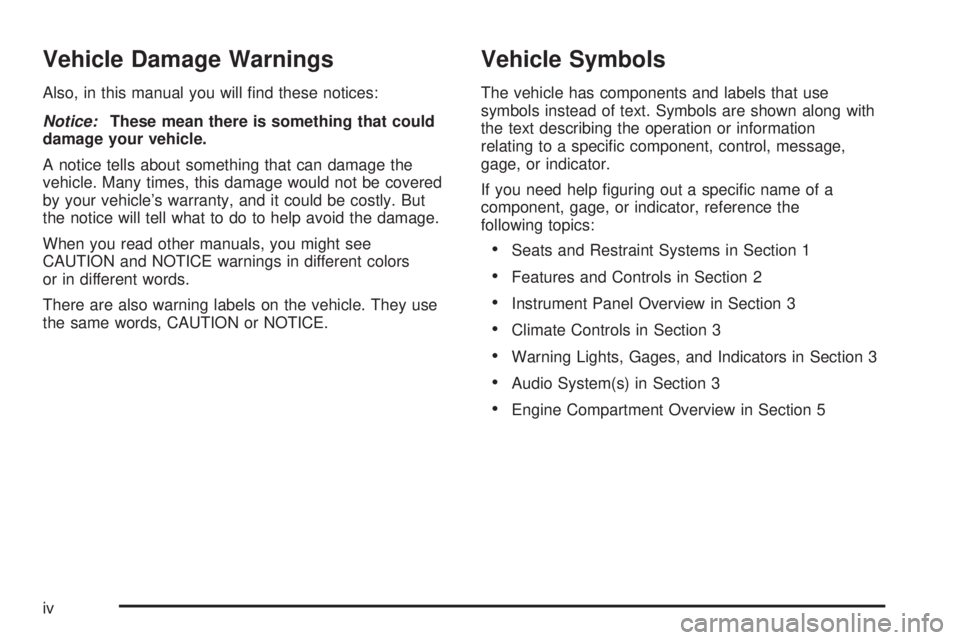
Vehicle Damage Warnings
Also, in this manual you will find these notices:
Notice:These mean there is something that could
damage your vehicle.
A notice tells about something that can damage the
vehicle. Many times, this damage would not be covered
by your vehicle’s warranty, and it could be costly. But
the notice will tell what to do to help avoid the damage.
When you read other manuals, you might see
CAUTION and NOTICE warnings in different colors
or in different words.
There are also warning labels on the vehicle. They use
the same words, CAUTION or NOTICE.
Vehicle Symbols
The vehicle has components and labels that use
symbols instead of text. Symbols are shown along with
the text describing the operation or information
relating to a specific component, control, message,
gage, or indicator.
If you need help figuring out a specific name of a
component, gage, or indicator, reference the
following topics:
•Seats and Restraint Systems in Section 1
•Features and Controls in Section 2
•Instrument Panel Overview in Section 3
•Climate Controls in Section 3
•Warning Lights, Gages, and Indicators in Section 3
•Audio System(s) in Section 3
•Engine Compartment Overview in Section 5
iv
Page 5 of 318
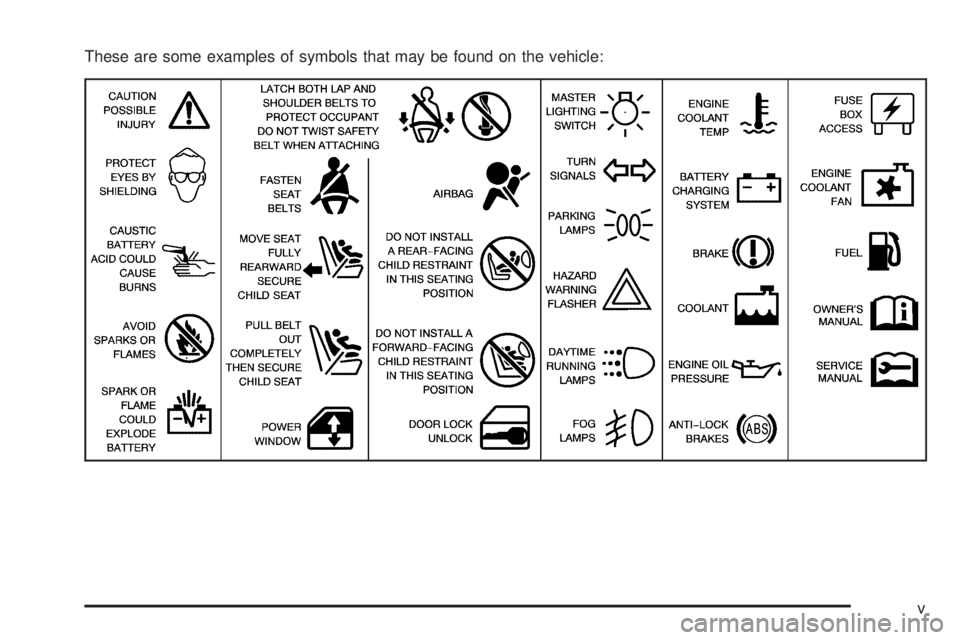
These are some examples of symbols that may be found on the vehicle:
v
Page 6 of 318
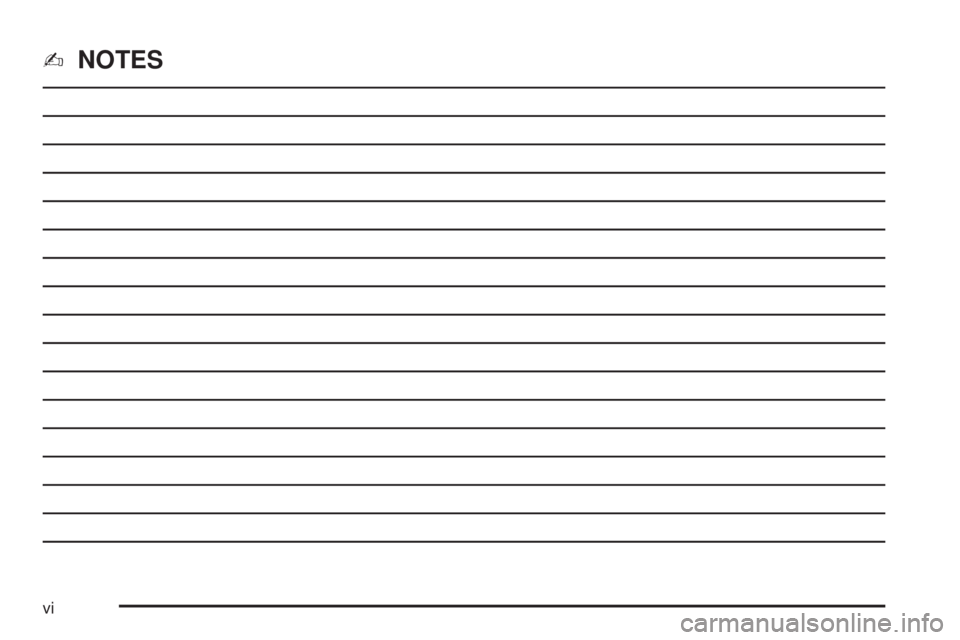
✍NOTES
vi
Page 7 of 318
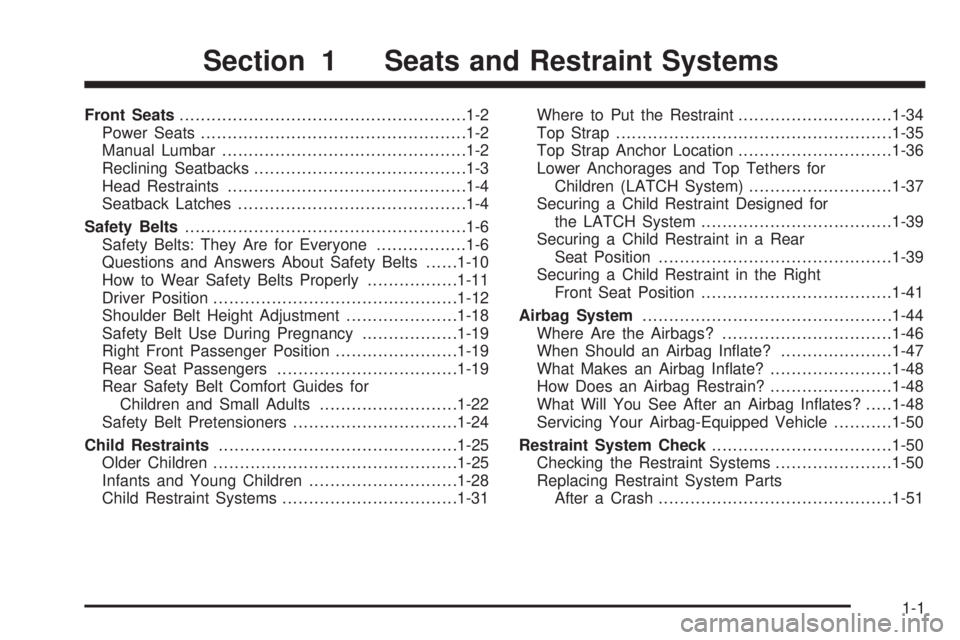
Front Seats......................................................1-2
Power Seats..................................................1-2
Manual Lumbar..............................................1-2
Reclining Seatbacks........................................1-3
Head Restraints.............................................1-4
Seatback Latches...........................................1-4
Safety Belts.....................................................1-6
Safety Belts: They Are for Everyone.................1-6
Questions and Answers About Safety Belts......1-10
How to Wear Safety Belts Properly.................1-11
Driver Position..............................................1-12
Shoulder Belt Height Adjustment.....................1-18
Safety Belt Use During Pregnancy..................1-19
Right Front Passenger Position.......................1-19
Rear Seat Passengers..................................1-19
Rear Safety Belt Comfort Guides for
Children and Small Adults..........................1-22
Safety Belt Pretensioners...............................1-24
Child Restraints.............................................1-25
Older Children..............................................1-25
Infants and Young Children............................1-28
Child Restraint Systems.................................1-31Where to Put the Restraint.............................1-34
Top Strap....................................................1-35
Top Strap Anchor Location.............................1-36
Lower Anchorages and Top Tethers for
Children (LATCH System)...........................1-37
Securing a Child Restraint Designed for
the LATCH System....................................1-39
Securing a Child Restraint in a Rear
Seat Position............................................1-39
Securing a Child Restraint in the Right
Front Seat Position....................................1-41
Airbag System...............................................1-44
Where Are the Airbags?................................1-46
When Should an Airbag Inflate?.....................1-47
What Makes an Airbag Inflate?.......................1-48
How Does an Airbag Restrain?.......................1-48
What Will You See After an Airbag Inflates?.....1-48
Servicing Your Airbag-Equipped Vehicle...........1-50
Restraint System Check..................................1-50
Checking the Restraint Systems......................1-50
Replacing Restraint System Parts
After a Crash............................................1-51
Section 1 Seats and Restraint Systems
1-1
Page 8 of 318
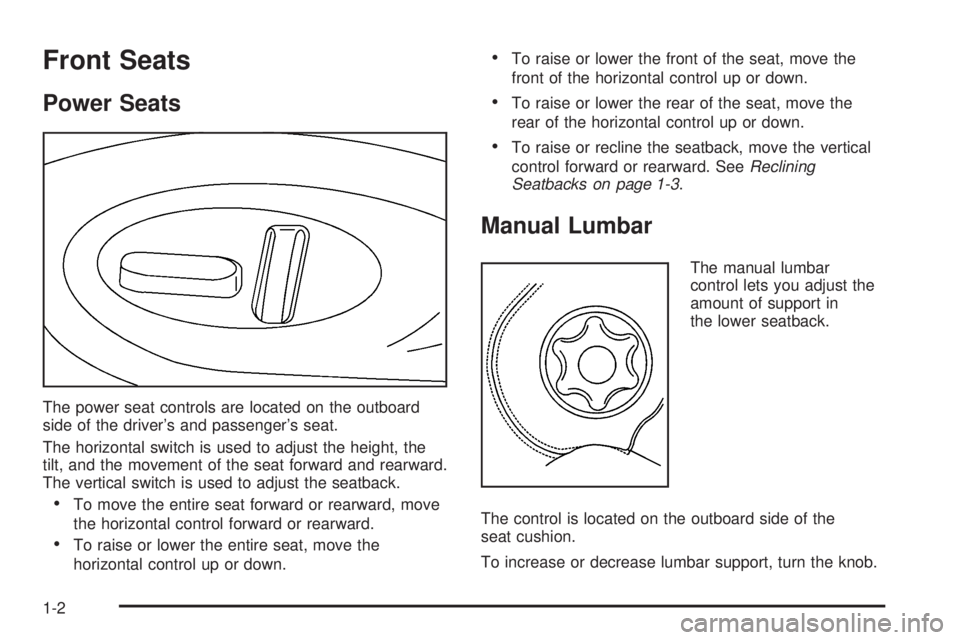
Front Seats
Power Seats
The power seat controls are located on the outboard
side of the driver’s and passenger’s seat.
The horizontal switch is used to adjust the height, the
tilt, and the movement of the seat forward and rearward.
The vertical switch is used to adjust the seatback.
•To move the entire seat forward or rearward, move
the horizontal control forward or rearward.
•To raise or lower the entire seat, move the
horizontal control up or down.
•To raise or lower the front of the seat, move the
front of the horizontal control up or down.
•To raise or lower the rear of the seat, move the
rear of the horizontal control up or down.
•To raise or recline the seatback, move the vertical
control forward or rearward. SeeReclining
Seatbacks on page 1-3.
Manual Lumbar
The manual lumbar
control lets you adjust the
amount of support in
the lower seatback.
The control is located on the outboard side of the
seat cushion.
To increase or decrease lumbar support, turn the knob.
1-2
Page 9 of 318
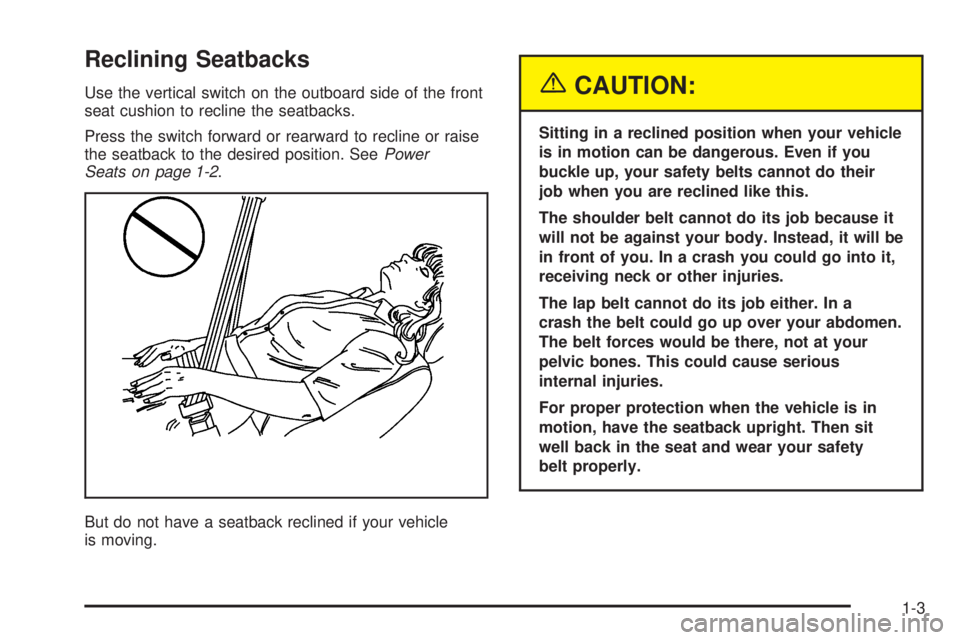
Reclining Seatbacks
Use the vertical switch on the outboard side of the front
seat cushion to recline the seatbacks.
Press the switch forward or rearward to recline or raise
the seatback to the desired position. SeePower
Seats on page 1-2.
But do not have a seatback reclined if your vehicle
is moving.{CAUTION:
Sitting in a reclined position when your vehicle
is in motion can be dangerous. Even if you
buckle up, your safety belts cannot do their
job when you are reclined like this.
The shoulder belt cannot do its job because it
will not be against your body. Instead, it will be
in front of you. In a crash you could go into it,
receiving neck or other injuries.
The lap belt cannot do its job either. In a
crash the belt could go up over your abdomen.
The belt forces would be there, not at your
pelvic bones. This could cause serious
internal injuries.
For proper protection when the vehicle is in
motion, have the seatback upright. Then sit
well back in the seat and wear your safety
belt properly.
1-3
Page 10 of 318
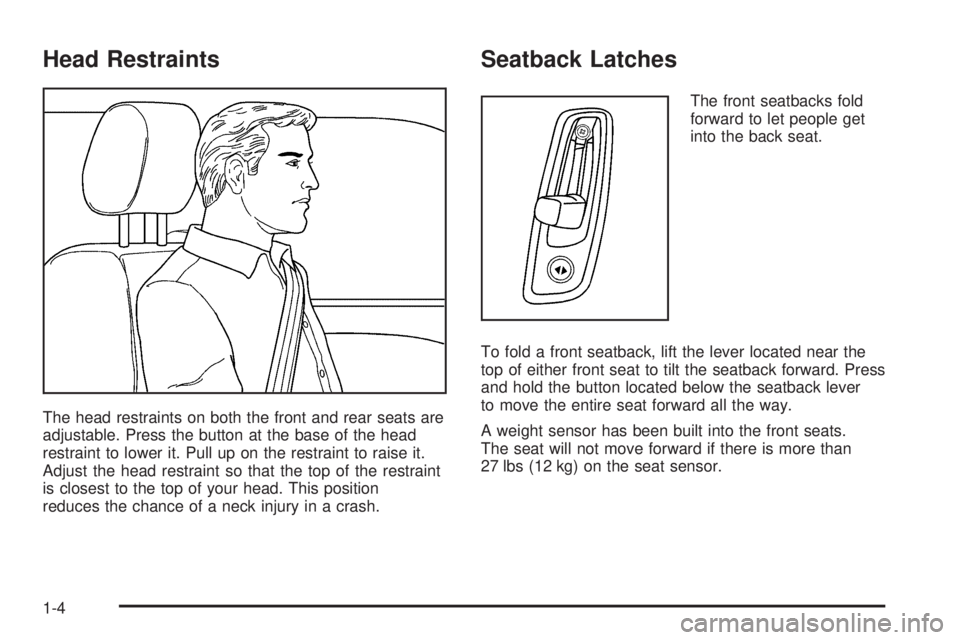
Head Restraints
The head restraints on both the front and rear seats are
adjustable. Press the button at the base of the head
restraint to lower it. Pull up on the restraint to raise it.
Adjust the head restraint so that the top of the restraint
is closest to the top of your head. This position
reduces the chance of a neck injury in a crash.
Seatback Latches
The front seatbacks fold
forward to let people get
into the back seat.
To fold a front seatback, lift the lever located near the
top of either front seat to tilt the seatback forward. Press
and hold the button located below the seatback lever
to move the entire seat forward all the way.
A weight sensor has been built into the front seats.
The seat will not move forward if there is more than
27 lbs (12 kg) on the seat sensor.
1-4